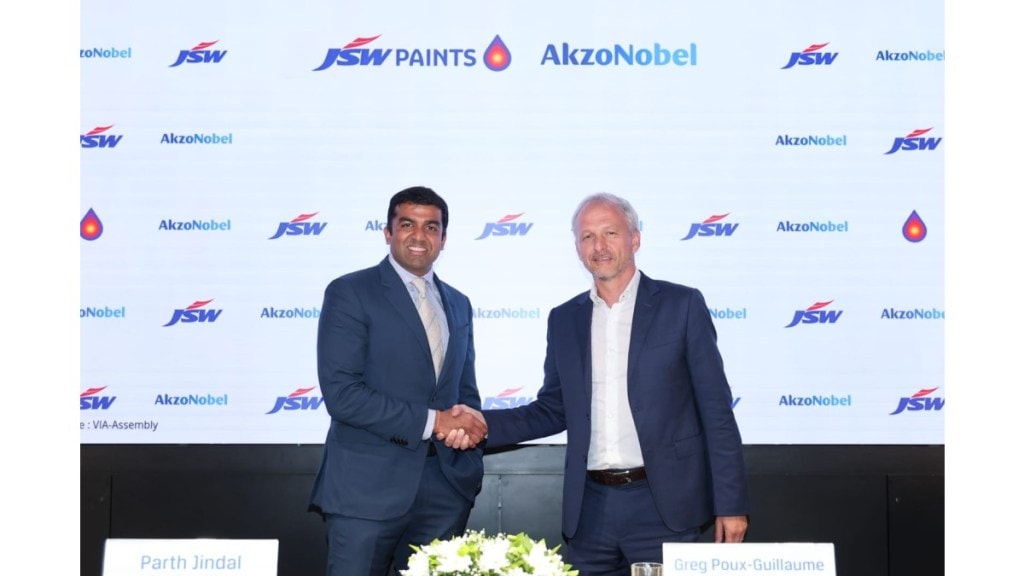JSW Paints is aiming higher than its current position as the fourth-largest paint maker in the country, following its acquisition of AkzoNobel India’s decorative paints business, managing director Parth Jindal tells Viveat Susan Pinto in an exclusive interaction. He outlines the key strategies being put in place to break into the top three. AkzoNobel’s global CEO, Gregoire Poux-Guillaume, also shares the company’s future plans in India after its partial exit, including a sharper focus on powder coatings, which have wide industrial applications. Excerpts:
How do you plan to become the third-largest paint company in three years? Given the intense competition, isn’t that timeline a bit long?
Parth Jindal: While we would like to get into the top three as soon as possible, we also believe that the target should be achieved in a sustainable manner. If you look at FY25 numbers, we will have a top line of about Rs 6,000 crore as a combined entity (JSW-Akzo). This puts us within striking distance of the third-largest player in the market (Kansai Nerolac). Having said that, there is no point in buying market share by offering heavy discounts, which would dilute the JSW and Dulux brand names. But, there are a few areas where we can scale up quickly. One is distribution. AkzoNobel has about 19,000 retailers across the country.
JSW Paints has about 9,000 retailers. The overlap is about 10%. If we take that out, it would mean access to a combined retailer base of about 26,000 to 27,000. We will leverage this retailer base to grow the business. The second aspect is the brand architecture. Dulux is strong in the premium segment, and JSW Paints is strong in the mass and value segments. We will straddle the price pyramid with our new brand architecture. The third aspect is manufacturing. The coming together of JSW Paints and AkzoNobel India will unlock our capacities. AkzoNobel India has five plants. We have two, which will soon become three plants. This will give us enough firepower to double our revenue to Rs 12,000 crore in the future.
What is your strategy for the industrial paints segment, where you are a number two player?
Parth Jindal: The plan would be to be the leading player in industrial paints as we go ahead. For this, our collaboration with AkzoNobel (as a technology partner) should help. We also plan to leverage the strengths of both brands—Dulux and JSW—to become the leader in industrial coatings. We are also looking at a broader spectrum of construction chemicals and waterproofing besides paints to become a well-rounded player. Our strengths in cement and steel should also help us achieve this objective.
What’s AkzoNobel’s plan for its future in India after exiting decorative paints?
Gregoire Poux-Guillame: The exit from decorative paints leaves us with the powder coatings business in India as well as the international R&D centre. We will retain full ownership of this business. We will also remain the technology partner to JSW across all its coating segments for which the latter will pay us a royalty fee of 4.5% of sales.
At a broader level, though, powder coatings are a fast-growing business and have a number of industrial applications. Such as in electric vehicles. That is a big segment for us here in India. Going forward, we are also looking at the prospect of introducing some other businesses into the country, such as aerospace coatings. Aerospace maintenance facilities are growing in India, and that gives us an opportunity to have a presence here in India with our offering in the space. In short, India is a significant market for us despite the exit from decorative paints.
Why did AkzoNobel exit decorative paints, given that it’s larger than industrial paints in India?
Gregoire Poux-Guillame: India is an exciting market, but it is also a unique market where local players are taking over from international companies. It is a market that requires deep local understanding and scale. And we had to make that choice whether we wanted to offer that scale or focus on other parts of the business, such as powder coatings. While decorative paints in India in the past had a number of international players, it will now be left with just one international player in Kansai Nerolac once this (JSW-Akzo) deal is completed. The partial exit was carefully thought through. It allows us to focus on what we are good at and leave the decorative business in the hands of a good local partner.
How do you plan to fund the deal, given the Rs 9,000 crore upfront cost and the Rs 4,000 crore open offer?
Parth Jindal: We plan to fund the deal partly through internal accruals, bank debt and private equity. The ratio will be roughly one-third for all three. About 70% of the funds have been tied up through the Jindal family and internal accruals of the JSW Group. For the remaining 30%, we are looking at partnering with private equity (PE) firms. At the moment, there are enough offers from PE firms, and we are in the process of selecting which one to go ahead with. As a backup, we have also arranged the balance 30% of the funds from the (JSW) group. If we get it, well and good, if we don’t, there will not be an issue.
Do you have any plans to delist AkzoNobel India after the open offer is completed?
Parth Jindal: We intend to keep Akzo Nobel India as a listed entity. We are also not looking to increase the stake beyond 75%. We may also continue with the current management of AkzoNobel India, though the first priority for us is to get the necessary approvals from the regulators, including the Competition Commission of India (CCI) and complete the transaction (including the open offer). We hope to do all of this by the end of the current calendar year.

